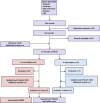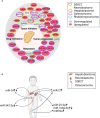Extracellular Vesicles: A New Source of Biomarkers in Pediatric Solid Tumors? A Systematic Review
- PMID: 35686092
- PMCID: PMC9173703
- DOI: 10.3389/fonc.2022.887210
Extracellular Vesicles: A New Source of Biomarkers in Pediatric Solid Tumors? A Systematic Review
Abstract
Virtually every cell in the body releases extracellular vesicles (EVs), the contents of which can provide a "fingerprint" of their cellular origin. EVs are present in all bodily fluids and can be obtained using minimally invasive techniques. Thus, EVs can provide a promising source of diagnostic, prognostic, and predictive biomarkers, particularly in the context of cancer. Despite advances using EVs as biomarkers in adult cancers, little is known regarding their use in pediatric cancers. In this review, we provide an overview of published clinical and in vitro studies in order to assess the potential of using EV-derived biomarkers in pediatric solid tumors. We performed a systematic literature search, which yielded studies regarding desmoplastic small round cell tumor, hepatoblastoma, neuroblastoma, osteosarcoma, and rhabdomyosarcoma. We then determined the extent to which the in vivo findings are supported by in vitro data, and vice versa. We also critically evaluated the clinical studies using the GRADE (Grading of Recommendations Assessment, Development, and Evaluation) system, and we evaluated the purification and characterization of EVs in both the in vivo and in vitro studies in accordance with MISEV guidelines, yielding EV-TRACK and PedEV scores. We found that several studies identified similar miRNAs in overlapping and distinct tumor entities, indicating the potential for EV-derived biomarkers. However, most studies regarding EV-based biomarkers in pediatric solid tumors lack a standardized system of reporting their EV purification and characterization methods, as well as validation in an independent cohort, which are needed in order to bring EV-based biomarkers to the clinic.
Keywords: desmoplastic small round cell tumor; extracellular vesicles; hepatoblastoma; neuroblastoma; osteosarcoma; pediatric oncology; rhabdomyosarcoma; solid tumors.
Copyright © 2022 Lak, van der Kooi, Enciso-Martinez, Lozano-Andrés, Otto, Wauben and Tytgat.
Conflict of interest statement
The authors declare that the research was conducted in the absence of any commercial or financial relationships that could be construed as a potential conflict of interest.
Figures




References
Publication types
LinkOut - more resources
Full Text Sources

